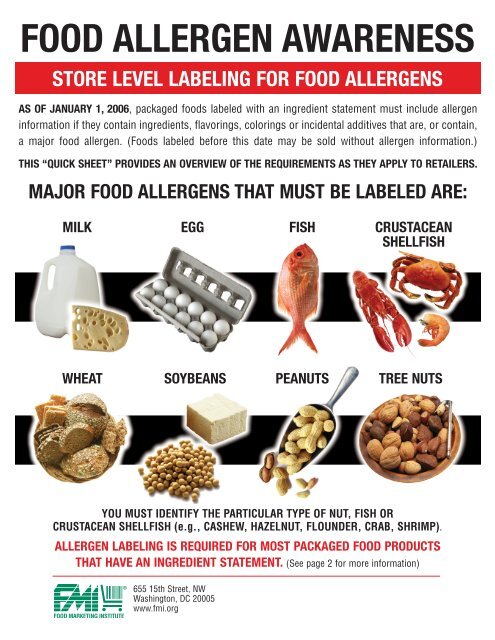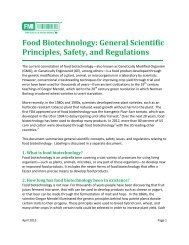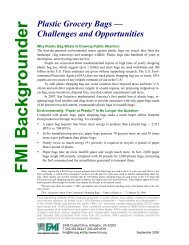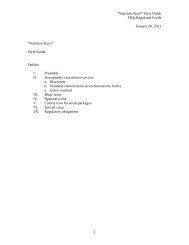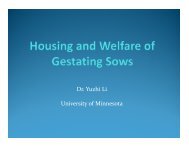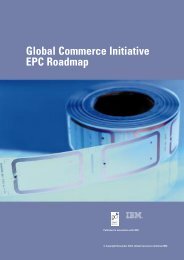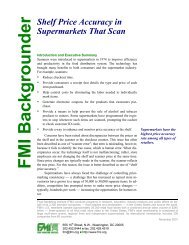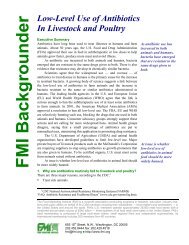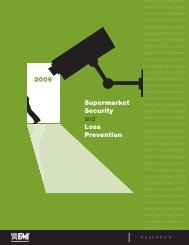FOOD ALLERGEN AWARENESS
FOOD ALLERGEN AWARENESS
FOOD ALLERGEN AWARENESS
You also want an ePaper? Increase the reach of your titles
YUMPU automatically turns print PDFs into web optimized ePapers that Google loves.
<strong>FOOD</strong> <strong>ALLERGEN</strong> <strong>AWARENESS</strong>STORE LEVEL LABELING FOR <strong>FOOD</strong> <strong>ALLERGEN</strong>SAS OF JANUARY 1, 2006, packaged foods labeled with an ingredient statement must include allergeninformation if they contain ingredients, flavorings, colorings or incidental additives that are, or contain,a major food allergen. (Foods labeled before this date may be sold without allergen information.)THIS “QUICK SHEET” PROVIDES AN OVERVIEW OF THE REQUIREMENTS AS THEY APPLY TO RETAILERS.MAJOR <strong>FOOD</strong> <strong>ALLERGEN</strong>S THAT MUST BE LABELED ARE:MILK EGG FISH CRUSTACEANSHELLFISHWHEAT SOYBEANS PEANUTS TREE NUTSYOU MUST IDENTIFY THE PARTICULAR TYPE OF NUT, FISH ORCRUSTACEAN SHELLFISH (e.g., CASHEW, HAZELNUT, FLOUNDER, CRAB, SHRIMP).<strong>ALLERGEN</strong> LABELING IS REQUIRED FOR MOST PACKAGED <strong>FOOD</strong> PRODUCTSTHAT HAVE AN INGREDIENT STATEMENT. (See page 2 for more information)655 15th Street, NWWashington, DC 20005www.fmi.org
STORE LEVEL LABELING FOR <strong>FOOD</strong> <strong>ALLERGEN</strong>SYOU MAY IDENTIFY <strong>ALLERGEN</strong>S IN EITHER ONE OF THE FOLLOWING TWO WAYS:1. Use a “Contains [followed by the name of food source from which the major food allergen is derived]”statement immediately after or next to the list of ingredients.Example: “Contains milk and wheat”The statement must identify the sources of all major food allergens contained in the food, even if someof the allergens are immediately identifiable in the ingredient list.The type size must be equal to or larger than the list of ingredients.2. Place the common or usual name of the major food allergen in the list of ingredients, followed inparentheses by the name of the food source from which the major allergen is derived.Required when the name of the major food allergen does not appear elsewhere in ingredient statement.Examples: “natural flavoring (egg, soy)” or “natural flavor (milk), sodium caseinate, whey”AN INGREDIENT STATEMENT (AND, THEREFORE, <strong>ALLERGEN</strong> INFORMATION) IS REQUIREDFOR THE FOLLOWING <strong>FOOD</strong>S:Packaged foods with two or more ingredients. A sandwich ordered from a deli counter and placed in asanitary wrapper such as a paper wrapper is not considered packaged, but a pre-made sandwich placedin a plastic clamshell and sold from a self-service retail display is considered packaged.Food not intended for immediate consumption that is pre-portioned and packaged by theretailer prior to display.Example: a cake frosted at the store that is sold in a packaged form.Food sold in bulk from self-service bins. Ingredient information must be provided on either the bulk binin plain view of the consumer or on a card, sign or other medium.<strong>ALLERGEN</strong> LABELING IS NOT REQUIRED FOR:Unpackaged foods or foods given to the consumer in only a sanitary wrapper (see above).Foods prepared or portioned according to a customer or employee order, whether the food is intendedfor immediate consumption (e.g., ice cream cone or pizza) or not (salad bar, deli salad portioned accordingto a customer order).Foods regulated by the U.S. Department of Agriculture (e.g., meat, poultry).Raw agricultural products in their natural state (e.g., raw fruits and vegetables).Highly refined oils and ingredients containing these oils.You may use a “May contain [specific allergen(s)]” statement to notify consumers about the possible presence of an allergen ina food product when cross-contamination with a major food allergen cannot be avoided by good manufacturing practices2


